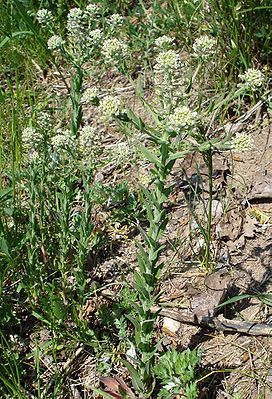Field cress
| Field cress | ||||||||||||
|---|---|---|---|---|---|---|---|---|---|---|---|---|

Field cress ( Lepidium campestre ) |
||||||||||||
| Systematics | ||||||||||||
|
||||||||||||
| Scientific name | ||||||||||||
| Lepidium campestre | ||||||||||||
| ( L. ) WTAiton |
The field cress ( Lepidium campestre ) is a species of the cruciferous family (Brassicaceae).
description
The field cress is an annual or biennial herbaceous plant that usually reaches heights of between 12 and 50 (8 to 60) cm. It grows upright and has a downy, tomentose hairy stem , which is typically branched in the upper area.
The lower leaves are elongated in shape and narrowed into the petiole. They are dentate at the edge or seldom lyre-shaped, pinnately lobed. The upper ones are only serrated.
The flowering time of the field cress is mainly from May to July. The racemose inflorescences do not contain bracts . The hermaphrodite flowers are fourfold. The four hairy to smooth sepals are (rarely 1 to) mostly 1.3 to 1.8 mm long. The four white petals nailed to their base usually have a length of 1.8 to 2.5 (1.5 to 3) mm and a width of (0.2 to) usually 0.5 to 0.7 mm. The six stamens consist of mostly 1.5 to 1.8 (1.2 to 2) mm long stamens and 0.3 to 0.5 mm long anthers . The short style ending in a capitate, yellowish scar .
The egg-shaped, 5 to 6 mm long pods are broadly winged from the center and densely covered with scaly vesicles. The short style barely protrudes from the edge of the ripe fruit. Typical of this species are the scale-like vesicles that cover the pods. Each fruit compartment contains only one seed . The dark brown seeds have a length of 2 to 2.3 (rarely up to 2.8) mm and a diameter of 1 to 1.3 mm. The fruit ripens from June to August.
The species has chromosome number 2n = 16.
Auto ecology
The field cress often thrives as a winter annual plant.
The pods, which stand horizontally when ripe, burst when the rain falls and the seeds are thrown out, so the pods act as rain ballists.
Occurrence
The original distribution area of the field cress extends from Europe to Western Asia and the Caucasus. It occurs in almost all of Europe, but is a neophyte in some countries in Northern and Eastern Europe , as well as in South Africa, North America, China, Japan, Australia, and New Zealand.
The field cress is common in Germany, but it is rarely found locally. In Austria it occurs more frequently in the Pannonian region , but is otherwise rare. It is common in Switzerland.
Lepidium campestre thrives in rubble and field weed societies, especially in societies of the Fumario-Euphorbion association, but also in those of the Sisymbrion association. It prefers moderately dry to fresh, nutrient- and base-rich, humus loam or clay soils.
use
The green parts of the plant can be eaten raw or cooked. The unripe pods and seeds can be used for seasoning.
swell
- Tai-yien Cheo, Lianli Lu, Guang Yang, Ihsan Al-Shehbaz & Vladimir Dorofeev: Brassicaceae: Lepidium campestre , p. 29 - same text online as the printed work , In: Wu Zheng-yi & Peter H. Raven (eds.): Flora of China , Volume 8 - Brassicaceae through Saxifragaceae , Science Press and Missouri Botanical Garden Press, Beijing and Saint Louis, 2002, ISBN 0-915279-93-2 . (Section description)
- Ruprecht Düll , Herfried Kutzelnigg : Pocket dictionary of plants in Germany and neighboring countries. The most common Central European species in portrait . 7th, corrected and enlarged edition. Quelle & Meyer, Wiebelsheim 2011, ISBN 978-3-494-01424-1 . (Section ecology)
literature
- Henning Haeupler , Thomas Muer: picture atlas of the fern and flowering plants of Germany (= the fern and flowering plants of Germany. Volume 2). Published by the Federal Agency for Nature Conservation. Ulmer, Stuttgart 2000, ISBN 3-8001-3364-4 .
- Wolfgang Adler, Karl Oswald, Raimund Fischer: Excursion flora of Austria. Ed .: Manfred A. Fischer . Ulmer, Stuttgart / Vienna 1994, ISBN 3-8001-3461-6 .
- August Binz , Christian Heitz: School and excursion flora for Switzerland , Schwabe & Co. AG, Basel, 1986, ISBN 3-7965-0832-4
- Erich Oberdorfer : Plant-sociological excursion flora , Ulmer Verlag, Stuttgart, 1990, ISBN 3-8001-3454-3
- Christian August Friedrich Garcke : Illustrierte Flora , Verlag Paul Parey, Berlin and Hamburg, 1972, ISBN 3-489-68034-0
Individual evidence
- ↑ a b c Erich Oberdorfer : Plant-sociological excursion flora for Germany and neighboring areas . 8th edition. Page 443. Stuttgart, Verlag Eugen Ulmer, 2001. ISBN 3-8001-3131-5
- ↑ a b c Lepidium in the Germplasm Resources Information Network (GRIN), USDA , ARS , National Genetic Resources Program. National Germplasm Resources Laboratory, Beltsville, Maryland. Retrieved July 28, 2017.
- ↑ Euro + med
Web links
- Field cress. In: FloraWeb.de.
- Distribution map for Germany. In: Floraweb .
- Lepidium campestre (L.) R. Br. In: Info Flora , the national data and information center for Swiss flora . Retrieved October 26, 2015.
- Distribution in the northern hemisphere according to: Eric Hultén , Magnus Fries: Atlas of North European vascular plants 1986, ISBN 3-87429-263-0
- Thomas Meyer: Data sheet with identification key and photos at Flora-de: Flora von Deutschland (old name of the website: Flowers in Swabia )
- Characteristics. (English)
- Characteristics. (German)
- Entry in Plants for a Future . (English)


